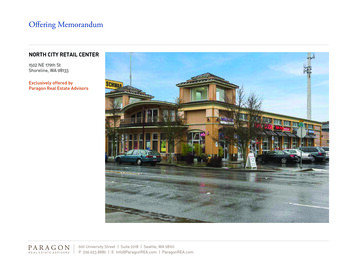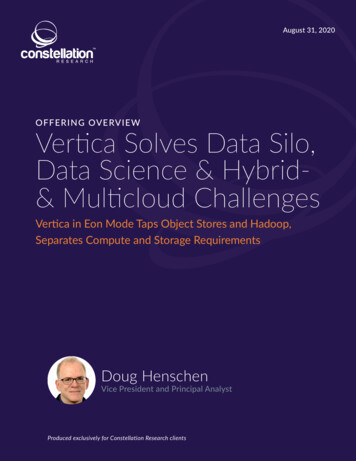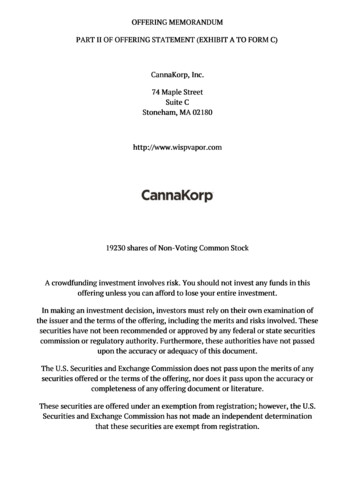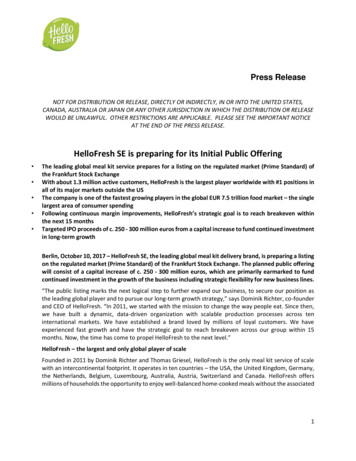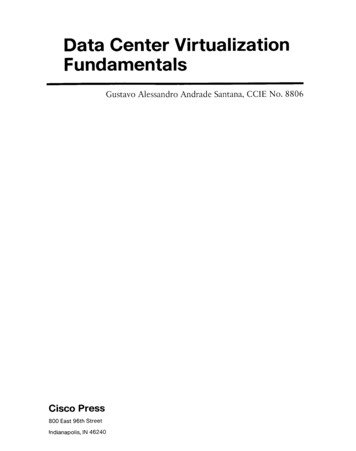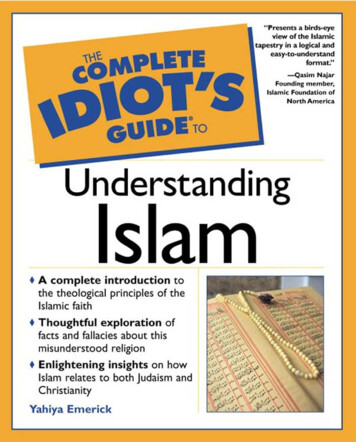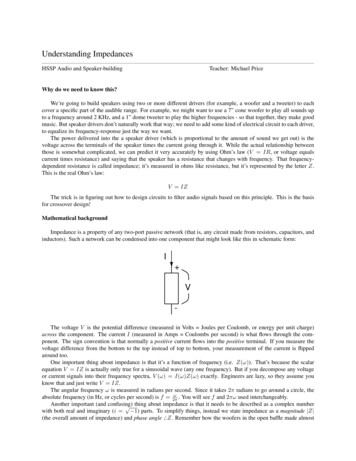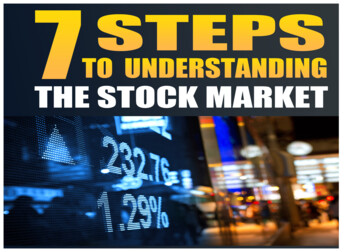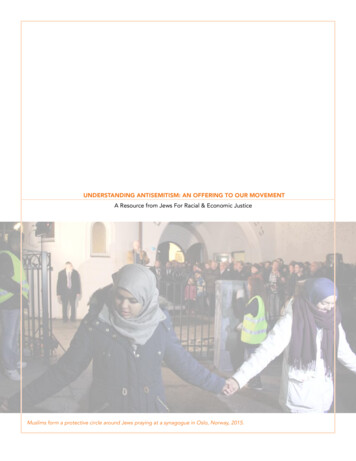
Transcription
Understanding Antisemitism: An Offering to our MovementA Resource from Jews For Racial & Economic JusticeMuslims form a protective circle around Jews praying at a synagogue in Oslo, Norway, 2015.
This project was conceived in conversation between Aurora Levins Morales andDove Kent, and grew from a series of teaching calls about the impact of antisemitismon JFREJ’s organizing work. Aurora joined JFREJ for two years as a Poet and Elderin-Residence, contributed in substantial ways to shaping our vision, and wrote muchof the initial draft of this paper. The work then passed into other hands, but Auroraboth planted and watered the seeds.“Taking on anti-Jewish oppression is the act of building a Left not confined to reaction,but propelled by a deeper vision of a world we would actually want to live in.”— The Past Didn’t Go Anywhere, April Rosenblum, 2007Jews For Racial & Economic Justice
Understanding Antisemitism: An Offering to our MovementA Resource from Jews For Racial & Economic JusticeTable of ContentsIntroductionPart I - Background5 Where does our collective confusion come from? Many on the left (sometimes includingJews ourselves) don’t have a clear analysis of what antisemitism is, how it works, and why it matters.6 Why is an understanding of antisemitism important? For centuries the targeting andblaming of Jews has had the effect of confusing non-Jews (and sometimes Jews as well) about thetrue nature of systemic oppression and redirecting them toward ineffective or self-destructive resistance strategies, ultimately breaking down the social fabric of our movements.7 Who are Jews? A central way that antisemitism thrives is through myths and stereotypesabout Jews. These stereotypes benefit from a lack of clarity about who Jews actually are and ignorance about the demographics of our community.Part II - Understanding Antisemitism11 What is antisemitism? Originating in European Christianity, antisemitism is the form ofideological oppression that targets Jews. In Europe and the United States it has functioned to protect the prevailing economic system and the almost exclusively Christian ruling class by divertingblame for hardship onto Jews.15 In what ways is antisemitism different than other oppressions like anti-Black racism?Many oppressions, such as anti-Black racism in the United States, could be said to require a fixedhierarchy or binary values system. By contrast, antisemitism is often described as “cyclical.”17 An example of antisemitism and how it plays out in society An important example ofantisemitism at work is The Protocols of the Elders of Zion.18 An example of these false narratives today19 The impact of internalized antisemitism on Jews Because the oppression has come inwaves, because Jews have often been allowed to flourish between those waves, and because thesewaves have often broken over our communities when least expected, many Jews live with a kind ofsimmering fear.20 Is criticism of Israel antisemitic? Criticisms of Israel and Zionism are not inherently orinevitably anti-Jewish. All states, movements and ideologies should be scrutinized, and all forms ofinjustice denounced.21 Anti-Jewish and anti-Muslim oppression are closely related Antisemitism and Islamophobia are not only entangled, but deeply rooted in the same systems of white supremacy and Christian hegemony.22 Resistance: an unbroken tradition of solidarity and liberation At every point in our history, Jews and Jewish communities and institutions have resisted their oppression and the oppression of others.Part III - The Current Moment23 What is the relationship between antisemitism and white supremacy today? We mustbe careful to draw a distinction between white supremacists — including neo-Nazis and white nationalists — and the system of white supremacy.25 Racism and antisemitism collude to undermine movements for justice and liberation.Racism and antisemitism exploit racial and ethnic differences, and promote class anxiety and fearof political persecution. Historically, antisemitism has sown division within the poor and workingclasses, preventing the emergence of multi-class, multi-racial and multi-ethnic mass movements.29 How do we use awareness of antisemitism to build unity and stronger movements?First and foremost, we need to recognize our common interest in collective liberation for allpeople, and the centrality of ending white supremacy in the struggle to end all related systems ofoppression.30 ConclusionCreditsReading ListGlossaryResourcesUnderstanding Antisemitism3
This paper was authored by a multi-racial, multi-ethnic, intergenerational team including Black, Mizrahi and white Ashkenazi Jews, with editorial review and support by Jewswith ethnic and national identities from many countries including Puerto Rico, India, Iraq,Syria, as well as non-Jewish allies from many racial and ethnic backgrounds. The team alsoincludes significant class and gender diversity. Many of us live in New York City, however,there is geographic diversity as well.IntroductionAntisemitismis real. It isantitheticalto collectiveliberation; ithurts Jews and italso undermines,weakens andderails all of ourmovements forsocial justice.Content Warning:This document contains graphic imageryand discussion of violence and genocide.4Since the presidential campaign and election of Donald Trump, we have witnessed a surgeof blatant, anti-Jewish expression in broad daylight — neo-Nazis marching in Charlottesville,swastikas spray-painted on playgrounds, hate speech hurled at Jews in public, cemeteries desecrated, and bomb threats targeting Jewish congregations and community centers. DonaldTrump appointed a white nationalist anti-Semite as his chief strategist in the White House, andeven after his departure, others sharing his ideology remain in the administration, reflecting theviews of the President himself. White supremacists have gathered in Washington, D.C. to praiseTrump, using Nazi language and symbols as they celebrate his election. Anti-Jewish hate speechabounds on social media, particularly directed at Jewish journalists, while white supremacistcommentators have appeared on CNN, asking whether Jews are actually human.It’s understandable that many of us on the left — including many Jews — are deeply confusedabout how to assess and understand antisemitism as a phenomenon. How does the targeting ofJews fit into the matrix of oppressions alongside those that we are more familiar with, such asanti-Black racism or Islamophobia? How should we understand and contextualize the threat?Jewish history is complex and the contemporary relationship of many Jews to power and whiteness can be confusing, but the premise of this paper is simple: Antisemitism is real. It is antithetical to collective liberation; it hurts Jews and it also undermines, weakens and derails all ofour movements for social justice.Even though the threats that we face now did not originate on Election Day, this is a new moment of escalated danger for Jews, for all the communities we belong to, and for all the communities that we care about. In light of this new moment, we offer this paper. Antisemitism andfalse theories of Jewish power are in the DNA of the “alt-right” white nationalist movement inall of its various flavors, offshoots and precursors. Whether you are Jewish or not, there is nodefeating the right without also attacking antisemitism. And there is no getting free withoutending antisemitism.This paper is an offering from a team assembled by Jews For Racial & Economic Justice (JFREJ).It reflects the values, analysis and best knowledge of the authors. It is intended to be a usefulresource to our partners and allies in the movement left, especially non-Jewish (gentile) organizations and individuals. It is only a brief introduction to Jews, the Jewish context, antisemitism,and collective liberation; it is not an exhaustive or academic examination of any subject. In theinterest of brevity and clarity, this paper contains simplifications and omissions of which we areaware. It is only one resource and one perspective in a complex and ongoing conversation. Itis not the last word — or the last word from JFREJ — on this topic. As all of us on the left lookmore closely at this topic our analysis and knowledge will surely evolve, and we hope you readit generously and curiously with that in mind.Antisemitism must be eradicated for our collective liberation. Solidarity among Jews and allother groups targeted by oppression will come when we forge the deep, trusting relationshipsthat emerge through shared struggle and a visceral understanding of our mutual interest in defeating the forces of white supremacy and creating a world where all people are free.Jews For Racial & Economic Justice
Part I - BackgroundWhere does our collective confusion come from?Our confusion about antisemitism is understandable. Are today’s Jews actually oppressed orare we oppressors? Is criticising Israel antisemitic? Didn’t antisemitism end after World War IIwith the world’s outrage at the Nazi Holocaust of the 1930’s and 40’s? Are all Jews white? Are anyJews white? In a world where our undocumented neighbors are being rounded up and deported,hundreds of thousands of Black people are incarcerated, the police routinely murder People ofColor with impunity, and transwomen of Color are hunted by bigots and police alike, is antisemitism even important? Is it real?Many on the left (sometimes including Jews ourselves) don’t have a clear analysis of what antisemitism is, how it works, and why it matters. Some do not fully understand how oppressionsare mutually reinforcing, and because of that they dismiss anti-Jewish oppression as unimportant or even deny that it really exists. Debates about the nature of anti-Jewish oppression canbe dense and sometimes vicious, making it difficult to simply ask questions or know whoseperspective to trust.In recent decades, the political Jewish right and its Christian allies (particularly Christian Zionists) have consistently spoken loudly against what they describe as antisemitism. While it isnotable that they have sometimes seemed like the only people willing to discuss and call outantisemitism, they have distended the meaning of the term to include any critique of Israelor Israeli government policy (in some cases labeling such criticism “the new antisemitism”).While this is intended to suppress and delegitimize calls for justice in Palestine, it also spills overinto other areas of social justice work. Individual activists, whole organizations and even entiremovements have been tarred as antisemitic for the entirely legitimate act of criticizing Israeligovernment policy or the political ideology of Zionism.In reaction to the manipulations of the right, many on the left haven’t wanted to address antisemitism at all. To the extent that the left recognizes antisemitism, it often constricts the meaning to include only interpersonal, overt, or violent acts against Jews such as hate speech orvandalism. This ignores all of the historical evidence about the structural nature of anti-Jewishoppression. Originating in European Christianity, it incubated in the form of stereotypes aboutJews and sporadic acts of small-scale violence, but then ramped-up and entered periods of elevated hysteria where it became institutionalized and sometimes extremely lethal.But this is itself confusing, highlighting the wild extremes of Ashkenazi Jewish experience in thepast century. In the 1930s and ‘40s, the Nazi Holocaust in Germany decimated Europe’s Jewishpopulation but today American Jews are broadly secure and successful. For most of our historyJews have been small, vulnerable minorities in the societies in which we’ve lived, but in justthe past few decades some Jews settled in and took control of Palestine and created Israel — anethno-nationalist “Jewish State” complete with nuclear weapons. So what is it? Are Jews precarious and oppressed or safe and powerful? How should we think about ourselves, and how shouldothers see us? And in this moment do we focus on the scary, striking similarities between socialconditions in pre-war Germany and the United States today or on the many, many differences?It remains an open question whether the Holocaust was simply the latest, “greatest” outbreakof endless and ongoing cycles of antisemitism, or a last act that shifted the tide and marked afundamental change in the world that forever ended the type of widespread institutional antisemitism and state violence against Jews that we saw in Europe for centuries. We may not have adefinitive answer for decades or even centuries to come. However, the authors of this paper seethe possibility that this dangerous pattern of blaming Jews for difficult societal problems couldemerge again today.Understanding Antisemitism5
The stakes are too high to allow our collective confusion to persist as an impediment to effectiveorganizing and action. As Jews committed to social justice, we believe that everyone workingto resist the intensified oppression activated by the Trump administration needs clarity aboutanti-Jewish ideology. As Jews, we need friends who have our backs, and as a whole movementwe need to be able to see through the ways that both real antisemitism and false accusations ofantisemitism are used to divide and derail us. We offer this intersectional analysis as a resourceto strengthen our united movements as we all face the escalation of attacks from the right.Why is an understanding of antisemitism important?It should be concerning to everyone that this insidious and complex oppression is so marginally addressed by the movement left. Throughout history, an effect of antisemitism has been todistract and divide powerful movements for justice and equity, preserving oppressive systemsand benefitting ruling elites.jewish diversityA poor Jewish family of Aleppo, Syria in the early 20th Century. (Library of Congress)Black Jewish Leaders at the Jews of Color National Convening in 2016. (Photo: Desmond Reich)For centuries the targeting and scapegoating of Jews — either by individuals or societal systems — has had the effect of confusing non-Jews (and sometimes Jews as well) about the truenature of systemic oppression. This redirects them toward ineffective or self-destructive resistance strategies, ultimately breaking down the social fabric of our movements. Examples includethe anti-Jewish pogroms in Russia, the anti-Jewish campaigns led by Henry Ford1,2 and FatherCoughlin in the U.S. in the 1930s, the Farmer-Labor Party in Minnesota in 19383, the death ofcivil rights unionism in the 1940s4 and the Ocean Hill-Brownsville Schools Crisis of the 1960s. Itonly takes a quick glance at the conflicts over the Vision For Black Lives platform in 2016 or theMarch For Racial Justice in the summer of 2017 to see that a lack of clarity about antisemitism,from both non-Jews and Jews, is hurting our movements right now.One devastating impact of oppression is the way it leads us to believe that our interests and ourcommunities are at odds or in competition. In order to successfully fight the rise of fascism in12346Smith, David Norman. “The Social Construction of Enemies: Jews and the Representation of Evil.” Sociological Theory, vol. 14, no. 3, 1996, pp. 203–240. JSTOR, www.jstor.org/stable/3045387Woeste, Victoria Saker. “Insecure Equality: Louis Marshall, Henry Ford, and the Problem of DefamatoryAntisemitism, 1920-1929.” The Journal of American History, vol. 91, no. 3, 2004, pp. 877–905. JSTOR,www.jstor.org/stable/3662859Berman, Hyman. “Political Antisemitism in Minnesota during the Great Depression.” Jewish Social Studies, vol. 38, no. 3/4, 1976, pp. 247–264. JSTOR, www.jstor.org/stable/4466937Korstad, Robert R., Civil Rights Unionism: Tobacco Workers and the Struggle for Democracy in the MidTwentieth-Century South, UNC Press, 2003Jews For Racial & Economic Justice
the United States, we need to overcome this lie whenever it arises. To do so includes understanding the particular role that anti-Jewish sentiment plays in breaking up resistance movements.Jews and non-Jews have always had a mutual interest in each other’s liberation as we face theintimidating machinery of white supremacy, imperialism, and capitalism. To dismantle the entire deadly machine it is crucial that we address antisemitism — a dangerous, often hidden leverin the machine’s mechanism.Who are Jews?A central way that antisemitism thrives is through myths and stereotypes about Jews. Thesestereotypes benefit from a lack of clarity about who Jews actually are and ignorance about thedemographics of our community.Judaism is one of the three so-called “Abrahamic” religions, along with Christianity and Islam,which trace their roots to the biblical patriarch Abraham. Judaism predates both ChristianityZauod-el-Mara, Jewish Quarter, Alexandria, Egypt 1898.Bollywood star and Baghdadi Indian Jew Nadiraand Islam, but over time has been overtaken by both of them in numbers of adherents throughout the world.Between 722 and 73 BCE, Jewish population centers in the Middle East began to fragment dueto invasion and military conflict, and Jews were scattered throughout the region. From 63 CEuntil 70–73 CE, the Romans occupied Judea, which led to an uprising, a crackdown, and the final expulsion of Jews from their homeland in what is now Israel/Palestine. Many Jews remainedin the Middle East and North Africa, while many others migrated throughout the world in whatis known as the “Jewish diaspora,” with some settling in what is modern-day Europe and otherparts of the world.5,6,7,8Today, Jews are a tiny percentage of the U.S. population; there are 5.3 million Jews — approximately 2.2% of the total population of the country.9 Among those five million U.S. Jews arepeople of every race, gender, and economic status. There are Jews in every state of the U.S., wish-diaspora/Sheffer, Gabriel Gabi. “Is the Jewish Diaspora Unique? Reflections on the Diaspora’s Current Situation.”Israel Studies, vol. 10, no. 1, 2005, pp. 1–35. JSTOR, org/wiki/Jewish diasporaPew Research Center for Religion & Public Life, “A Portrait of Jewish Americans,” 2013, retrieved opulation-estimates/Understanding Antisemitism7
jewish diversityTwo Jews from Kaifeng,China, c. 1902.the largest absolute populations in New York, California, and Florida10 and the most per capitain New York, New Jersey and Washington D.C.11Jews are a racially and ethnically diverse community.Some Jewish ethnic groupsinclude Eastern and Western European and Russian (Ashkenazi); MiddleEastern, North African,Central Asian, and Balkan(Mizrahi); Ethiopian andUgandan (African); andSpanish and Portuguese(Sephardi).12 There aremixed-race Jews whose anBlack Jewish Civil RightsEthiopian Jews Protest incestors include many kindssupporter and entertainerJerusalem, 2012.of non-European peoples,Sammy Davis Jr. with Dr.and both white people andMartin Luther King, Jr.People of Color who havechosen (or whose parents,grandparents or ancestors have chosen) to become Jews through conversion. Somewhere between 11% and 20% of Jews in the United States are People of Color (depending on the methodology used and whom you consider to be “of Color”).13,14 There are also significant, ethnicallydiverse Jewish communities all over the world. Jews live in 70% of the world’s nations. From theancient community of Chinese Jews in Kaifeng15,16 to the B’nai, Cochini and Baghdadi Jews ofIndia and the many Jewish enclaves of Latin America, Jews come from every part of the world,and look every kinda way.17Tip: check your assumptionsDon’t make assumptions or generalize about Jews — that Person of Color next to you might be Jewish.Acknowledge the race and class diversity of the Jewish community, and ways in which Black and Arab Jewsare particularly targeted, as well as the ways that poor and working-class Jews are rendered invisible.Jews have been in the U.S. since the colonial period, though much of what we associate withJewish life and culture in the United States arrived with the large wave of Ashkenazi Jews emigrating from Eastern Europe between 1880 and 1921.18 In 1921, and again in 1924, motivated byantisemitism as well as racism toward Asians and other forms of xenophobia, congress passed10 ion-in-the-united-states-by-state11 https://en.wikipedia.org/wiki/American Jews#Significant Jewish population centers12 Hahn Tapper, Aaron J. Judaisms - A Twenty-First-Century Introduction to Jews and Jewish Identities, University of California Press, 201613 http://ajpp.brandeis.edu/14 http://www.bechollashon.org/population/north america/na color.php15 http://www.sino-judaic.org/index.php?page kaifeng jews history16 jewish-history-tour17 Hahn Tapper, Aaron J., Judaisms - A Twenty-First-Century Introduction to Jews and Jewish Identities, University of California Press, 201618 ne.php8Jews For Racial & Economic Justice
laws restricting the immigration of Jews and other groups to the U.S. based on a national originsquota, similar in spirit to Trump’s “Muslim Ban” today.19scientific racismJews are perhaps best described as suffering from “definitionalinstability” when it comes to race. According to Sander Gilman,“The general consensus of the ethnological literature of the latenineteenth century was that the Jews were ‘black’ or, at least swarthy. This view had a long history in European science.”20 In theUnited States, Jews were certainly not Black, but were not considered to be quite white either. This distinction was further entrenched by the advent of “scientific” racism.21 Jews faced somelegal barriers before and after the American Revolution, and werelater subjected to immigration restrictions and discrimination viahousing covenants as well as quotas and bans at educational institutions.22 However, these oppressions were nothing like thosefaced by African-Americans, Native Americans and many otherimmigrant groups. Like the Irish and Italians, light-skinned Jews“The Jewish Type.” Eugenic pseudosciencejustifying racism and antisemitism.of European descent once faced pervasive, racialized bigotry. Today they primarily identify as white and are read as white, benefitfrom white privilege, and participate in upholding the system ofwhite supremacy. However, this whiteness is contextual and conditional. While white supremacy may have embraced Jews of European descent in the last century, white supremacists havenever considered any Jews to be white, as was abundantly clear watching the neo-Nazi rallies inCharlottesville, VA in the summer of 2017. As we will explore shortly, antisemitic beliefs predatemodern white supremacy ideology. But white supremacy has since been incorporated into anMeanwhile, liketisemitism, creating a shifting, slippery mixture of religious intolerance, mythology and racism.This means that Jews can sometimes be racialized as white, but antisemitism persists, and whiteall other PeopleJews can still be considered “other” because of religious difference and cultural stereotypes. Asof Color, Jewsa community, we have the critical job of agitating many of our people around white privilegewhile also taking very seriously the impact that antisemitism has on us. We don’t see that workof Color areas contradictory.In the U.S. today, white Ashkenazi Jews sometimes assert that they are not white because theyare oppressed by other white people. Race is inherently fluid, nuanced and irrational and thereis much to learn by probing and interrogating how Jews of European descent are racialized today. However, the authors believe that white Jews do experience white access and privilege, andthat their claims arise from conflating the workings of antisemitism with the workings of racism, specifically anti-Black racism. What these white Jews are really saying is that they are notChristian white people. But being targeted by one oppression doesn’t negate being privileged by,complicit in, or acting as a perpetrator of another. White Ashkenazi Jewish racialization couldchange in the future, but in the here and now, such claims undermine the work of Jews of Colorincluding Mizrahim to challenge white supremacy within Jewish communities.the targets ofracism and whitesupremacy, whileas Jews they arealso targeted byantisemitism.Meanwhile, like all other People of Color, Jews of Color are the targets of racism and white supremacy, while as Jews they are also targeted by antisemitism. They simultaneously experienceracist marginalization, microaggressions and outright hostility (and often disbelief in their veryexistence) from white Jews, non-Jewish People of Color, and from U.S. society as a whole.19 The Emergency Quota Act of 1921 limited immigration in a given year to 3% of the total number of immigrants from any given country recorded in 1910; this affected not only Jews but a wide range of Eastern and Southern Europeans, among other nationalities. The Immigration Act of 1924 tightened it 2%of the number recorded in 1890 and entirely excluded Asian immigrants. See: igration-act20 Gilman, Sander L, Are Jews White?, Theories of Race and Racism: A Reader, 229–237, Routledge, 200021 Brodkin, Karen, How Jews Became White Folks And What That Says About Race In America, Rutgers University Press, 199822 Jonathan Sarna, American Judaism, ch. 2 and p. 374, 2004Understanding Antisemitism9
The false perception that all Jews are white permeates even the Jewish community and distortsthe way we see and treat each other, creating a complex colorism. A dark-skinned Mizrahi Jewmay not have their Jewish identity questioned by Ashkenazi Jews but they will still experiencethe type of bigotry that is directed at Arab people, anyone perceived to be Muslim, and at newand undocumented immigrants. Meanwhile, even a light-skinned Black, Latino, or East AsianJew would rarely be perceived as Jewish by anyone because of our collective misperceptionsabout where Jews come from and what they look like. Regardless of skin color, all Mizrahi Jewsexperience the cultural erasure of non-European history and tradition in our Jewish institutions, in addition to the deep rooted anti-Arab racism that permeates those institutions and oursociety as a whole. At the same time, Ashkenazi Jews of Color benefit from the normalizationof Ashkenazi culture within the Jewish community. But because of racism they often don’t haveaccess to the institutional power that tends to come with cultural dominance. Amidst all thecomplexities of how different Jews are racialized, it is Black Jews, at the end of day, who face themost virulent forms of racism and anti-Blackness within Jewish institutions and in Americansociety. It must be a core principle throughout our movements — and throughout the Jewishcommunity — that we create space for each other’s divergent experiences at the same time thatwe remain clear on who among us faces the greatest threats to safety.There is also great class diversity among Jews. The very wealthiest individuals on the planet arepredominantly Christian according to nonpartisan wealth research firm New World Wealth. In2015, their study found that more than half of the world’s millionaires identified as Christianand that there are more Hindu and Muslim millionaires than Jewish ones. Of the 13.1 millionpeople in the world who are millionaires, 56.2% were Christians, while 6.5% were Muslims,3.9% are Hindu and 1.7% are Jewish. Jews make up 11.6% of the world’s billionaires — higherthan Jews’ percentile in the world’s population, but a small fraction of the total.23 Contrary toconspiracy theories about Jews — and conspiracy theories about economic dominance in general — no single group controls the planet’s wealth.statsWhile Jews do not control hugeamounts of wealth, it is true thatin the U.S. Jews earn more incomethan most other religious and ethnic groups. This advantage does not,however, add up to some huge disparity for Jews as a whole. Some 25% ofJews in the U.S. report household incomes over 150,000, while 8% of thegeneral population reports the samehousehold incomes.24 However, Jewish adults make up a very small percentage of the U.S. population, only5.3 million out of 318 million (2.2%).That means that the vast majority ofhigh income people in the U.S. arenon-Jews. Also, these figures lookonly at income. They don’t measureassets, especially those passed downthrough multiple generations. Sincethe majority of U.S. Jews were poorand working-class immigrants only afew generations ago, looking at inher23 In 2013, Forbes Israel counted 165 Jewish billionaires in the world naires-worth-combined-812-billion/). The total Forbes count of world billionaires that yearwas 1426. 11.6% is thus an accurate figure for 2013.24 Pew Research Center for Religion & Public Life, “A Portrait of Jewish Americans,” 2013, retrieved udy/income-distribution/10Jews For Racial & Economic Justice
ited wealth would likely reveal an even greater concentration of resources in the hands of elite,white, non-Jewish families.25Many people incorrectly believe that there are no poor Jews or that the only poor Jews are theCharedi or ultra-Orthodox (Jews who reject secular culture, and are often identified in NewYork City by their black hats and/or wigs). According to a study by the Metropolitan Council onJewish Poverty, 45% of all children in Jewish households in New York now live below or near thepoverty line and the Jewish poverty rate is 26.4% — only slightly lower than the general pop
Racism and antisemitism exploit racial and ethnic differences, and promote class anxiety and fear of political persecution. Historically, antisemitism has sown division within the poor
